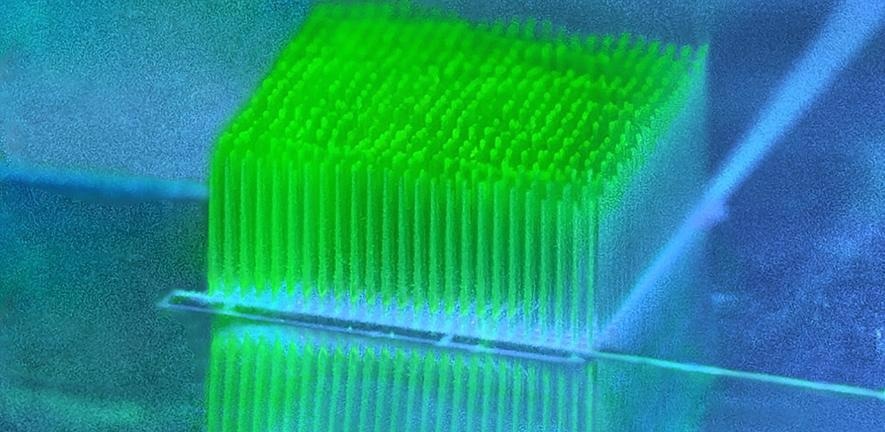3D printing was utilized by researchers at the University of Cambridge to make grids of high-rise “nano-housing” where sun-loving bacteria grow rapidly.
 3D-printed custom electrodes. Image Credit: Gabriella Bocchetti.
3D-printed custom electrodes. Image Credit: Gabriella Bocchetti.
It was then possible for the researchers to withdraw the bacteria’s waste electrons, which were left over from photosynthesis, and utilized it to power small electronics.
Other researchers extracted energy from photosynthetic bacteria; however, the Cambridge researchers identified that providing the bacteria with the right kind of home enhances the amount of energy they can extract by over an order of magnitude.
The method is competitive against conventional techniques of renewable bioenergy generation and has already reached solar conversion efficiencies that could exceed several current methods of biofuel generation.
The study outcomes have been reported in the Nature Materials journal. The findings set the stage for new avenues in bioenergy generation and indicate that “biohybrid” sources of solar energy can be a significant component in the zero-carbon energy mix.
Present renewable technologies, like silicon-based solar cells and biofuels, are substantially greater than fossil fuels with regard to carbon emissions. However, they also have limitations, like challenges in recycling, reliance on mining and a belief in farming and land use, which leads to biodiversity loss.
Our approach is a step towards making even more sustainable renewable energy devices for the future.
Dr. Jenny Zhang, Study Lead Researcher, Yusuf Hamied Department of Chemistry, University of Cambridge
Zhang and her collaborators from the Department of Biochemistry and the Department of Materials Science and Metallurgy are working to transform bioenergy into something that is scalable and sustainable.
Photosynthetic bacteria or cyanobacteria are the most abundant life form on Earth. For many years, scientists have been trying to “re-wire” the photosynthesis mechanisms of cyanobacteria to withdraw energy from them.
There’s been a bottleneck in terms of how much energy you can actually extract from photosynthetic systems, but no one understood where the bottleneck was. Most scientists assumed that the bottleneck was on the biological side, in the bacteria, but we’ve found that a substantial bottleneck is actually on the material side.
Dr. Jenny Zhang, Study Lead Researcher, Yusuf Hamied Department of Chemistry, University of Cambridge
To grow, cyanobacteria require lots of sunlight — like the surface of a lake in the summertime. Also, to withdraw the energy they produce via photosynthesis, the bacteria need to be fixed to electrodes.
The Cambridge group 3D-printed custom electrodes out of metal oxide nanoparticles customized to function with the cyanobacteria as they conduct photosynthesis. The electrodes were printed as highly branched, densely packed pillar structures, similar to a tiny city.
A printing method was developed by Zhang’s team, enabling control over multiple length scales, thereby making the structures highly customizable. By doing so, a broad range of fields could be benefited.
The electrodes have excellent light-handling properties, like a high-rise apartment with lots of windows. Cyanobacteria need something they can attach to and form a community with their neighbors. Our electrodes allow for a balance between lots of surface area and lots of light—like a glass skyscraper.
Dr. Jenny Zhang, Study Lead Researcher, Yusuf Hamied Department of Chemistry, University of Cambridge
As soon as the self-assembling cyanobacteria were in their new “wired” home, the scientists discovered that they were highly efficient compared to other current bioenergy technologies, like biofuels. The method increased the amount of energy withdrawn by more than an order of magnitude over other techniques for generating bioenergy from photosynthesis.
Zhang stated, “I was surprised we were able to achieve the numbers we did—similar numbers have been predicted for many years, but this is the first time that these numbers have been shown experimentally.”
“Cyanobacteria are versatile chemical factories. Our approach allows us to tap into their energy conversion pathway at an early point, which helps us understand how they carry out energy conversion so we can use their natural pathways for renewable fuel or chemical generation,” added Zhang.
This study was financially supported in part by the Biotechnology and Biological Sciences Research Council, the Cambridge Trust, the Isaac Newton Trust, and the European Research Council. Jenny Zhang is a BBSRC David Phillips Fellow in the Department of Chemistry, and a Fellow of Corpus Christi College, Cambridge.
Journal Reference:
Chen, X., et al. (2022) 3D-printed hierarchical pillar array electrodes for high-performance semi-artificial photosynthesis. Nature Materials. doi.org/10.1038/s41563-022-01205-5.